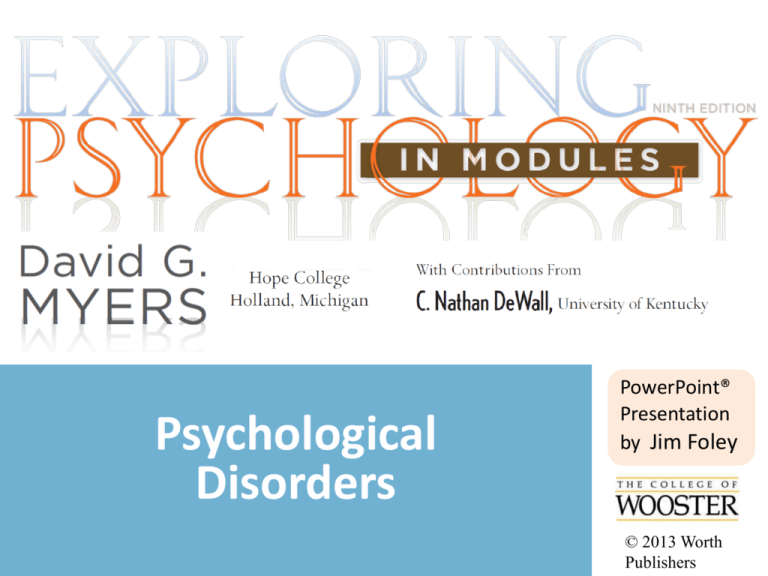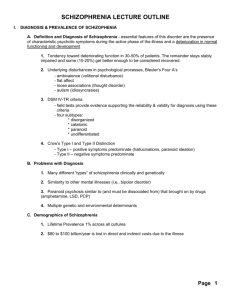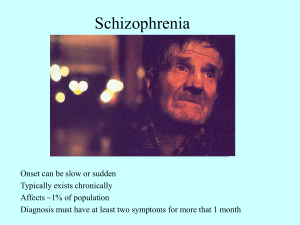Psychological Disorders
advertisement

Psychological Disorders PowerPoint® Presentation by Jim Foley © 2013 Worth Publishers Module 40: Schizophrenia Split from reality and from self Schizophrenia symptoms: Disorganized Thinking, Delusions Disturbed Perceptions: Hallucinations Unusual Emotions and Actions, including flat affect, and catatonia Subtypes Onset and course Causes of symptoms: Brain: Dopamine Overactivity Abnormal brain anatomy and activity Maternal virus during pregnancy Associated genes Schizophrenia: Psychosis refers to a mental split from reality and rationality. the mind is split from reality, e.g. a split from one’s own thoughts so that they appear as hallucinations. Schizophrenia symptoms include: disorganized and/or delusional thinking. disturbed perceptions. inappropriate emotions and actions. Positive and Negative Symptoms of Schizophrenia Positive + presence of problematic behaviors Hallucinations (illusory perceptions), especially auditory Delusions (illusory beliefs), especially persecutory Disorganized thought and nonsensical speech Bizarre behaviors Negative absence of healthy behaviors Flat affect (no emotion showing in the face) Reduced social interaction Anhedonia (no feeling of enjoyment) Avolition (less motivation, initiative, focus on tasks) Alogia (speaking less) Catatonia (moving less) Schizophrenia Symptoms: Problems in Thinking and Speaking Disorganized speech, including the “word salad” of loosely associated phrases Delusions (illusory beliefs), often bizarre and not just mistaken; most common are delusions of grandeur and of persecution Problems with selective attention, difficulty filtering thoughts and choosing which thoughts to believe and to say out loud ?!?! ?!?! Schizophrenia Symptoms: Disturbed Perceptions People with schizophrenia often experience hallucinations, that is, perceptual experiences not shared by others. The most common form of hallucination is hearing voices that no one else hears, often with upsetting (e.g. shaming) content. Hallucinations can also be visual, olfactory/smells, tactile/touch, or gustatory/taste. Am I evil? You’re evil! Schizophrenia Symptoms: Inappropriate Emotions and Actions Odd and socially inappropriate responses such as looking bored or amused while hearing of a death Flat affect: facial/body expression is “flat” with no visible emotional content Impaired perception of emotions, including not “reading” others’ intentions and feelings The schizophrenic body exhibits symptoms such as: repetitive behaviors such as rocking and rubbing. catatonia, such as sitting motionless and unresponsive for hours. Onset and Development of Schizophrenia Onset: Typically, schizophrenic symptoms appear at the end of adolescence and in early adulthood, later for women than for men. Prevalence: Nearly 1 in 100 people develop schizophrenia, slightly more men than women. Development: The course of schizophrenia can be acute/reactive or chronic. Course of Schizophrenia Acute/Reactive Schizophrenia In reaction to stress, some people develop positive symptoms such as hallucinations. – Recovery is likely. Chronic/Process Schizophrenia develops slowly, with more negative symptoms . – With treatment and support, there may be periods of a normal life, but not a cure. – Without treatment, this type of schizophrenia often leads to poverty and social problems. Subtypes of Schizophrenia Paranoid • Plagued by hallucinations, often with negative messages, and delusions, both grandiose and persecutory Disorganized • Primary symptoms are flat affect, incoherent speech, and random behavior Catatonic • Rarely initiating or controlling movement; copies others’ speech and actions Undifferentiated • Many varied symptoms Residual • Withdrawal continues after positive symptoms have disappeared Understanding Schizophrenia What’s going on in the brain in schizophrenia? Abnormal brain structure and activity Too many dopamine/D4 receptors help to explain paranoia and hallucinations; it’s like taking amphetamine overdoses all the time. Poor coordination of neural firing in the frontal lobes impairs judgment and self-control. The thalamus fires during hallucinations as if real sensations were being received. There is general shrinking of many brain areas and connections between them. Understanding Schizophrenia Are there biological risk factors affecting early development? Biological Risk Factors Schizophrenia is somewhat more likely to develop when one or more of these factors is present: low birth weight maternal diabetes older paternal age famine oxygen deprivation during delivery maternal virus during mid-pregnancy impairing brain development Schizophrenia is more likely to develop in babies born: during and after flu epidemics. in densely populated areas. a few months after flu season. after mothers had the flu during the second trimester, or had antibodies showing viral infection. The lesson is to: get flu shots with early fall pregnancies. Understanding Schizophrenia Are there genetic risk factors? If so, we would see more similar schizophrenia risk shared between identical twins than fraternal twins (graph below). Do we? Genetic Factors If one twin has schizophrenia, the chance of the other one also having it are much greater if the twins are identical. Having adoptive siblings (or parents) with schizophrenia does not increase the likelihood of developing schizophrenia. Understanding Schizophrenia Genetic and Prenatal Causes Even in quadruplets, genetics do not fully predict schizophrenia. This could be because of environmental differences. First difference: twins in separate placentas. Only one of two twins has the enlarged ventricles seen in schizophrenia. The Genain quadruplets share genes and all have schizophrenia but at different levels of severity: genes may interact with environment to produce this pattern.




